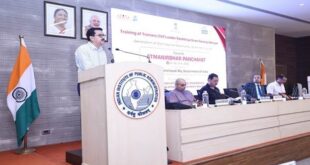- The World Bank has approved a loan of USD 1 billion to India to help the country prepare for future pandemics and strengthen its healthcare infrastructure.
- The loan will be split into two loans of USD 500 million each.
- The loan will be used to support India’s flagship Pradhan Mantri-Ayushman Bharat Health Infrastructure Mission (PM-ABHIM), which was launched in October 2021, and will improve the public healthcare infrastructure across the country.
- Both loans utilize the Program-for-Results financing instrument, which focuses on achieving results rather than inputs. The loans have a final maturity of 18.5 years, including a grace period of five years.
- The Public Health Systems for Pandemic Preparedness Program (PHSPP) will provide USD 500 million to support the government’s efforts to prepare India’s surveillance system to detect and report potential international epidemics.
- The Enhanced Health Service Delivery Program (EHSDP) will provide another USD 500 million to support the government’s efforts to strengthen service delivery through a redesigned primary healthcare model.
- One of the loans will also prioritize health service delivery in seven states: Andhra Pradesh, Kerala, Meghalaya, Odisha, Punjab, Tamil Nadu, and Uttar Pradesh.
Status of India’s Health Sector
- According to World Bank estimates, India’s performance in health has improved over time. India’s life expectancy has increased from 58 in 1990 to 70.19 in 2022.
- The under-five mortality rate, infant mortality rate, and maternal mortality ratio are all close to the average for India’s income level.
Major Issues:
- Inadequate Medical Infrastructure: India has a shortage of hospitals, particularly in rural areas, and many existing healthcare facilities lack basic equipment and resources.
- According to the National Health Profile, India has only 0.9 beds per 1000 population and out of which only 30% are in rural areas.
- Gap in Doctor-Patient Ratio: One of the most critical concerns is the gap in the doctor-patient ratio. According to the Indian Journal of Public Health, India needs 20 lakh doctors by 2030.
- However, currently a doctor in the government hospital attends to ~11000 patients, which is more than the WHO recommendation of 1:1000.
- Lack of Adequate Mental Healthcare: India has one of the lowest numbers of mental health care professionals per capita.
- Government’s spending on mental health is also very low. This has resulted in poor mental health outcomes and inadequate care for people suffering from mental illness.
SOURCE: THE HINDU, THE ECONOMIC TIMES, PIB
 Chinmaya IAS Academy – Current Affairs Chinmaya IAS Academy – Current Affairs
Chinmaya IAS Academy – Current Affairs Chinmaya IAS Academy – Current Affairs



